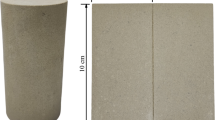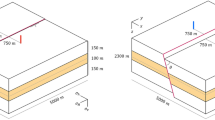Abstract
The TOUGH+Millstone simulator has been developed for the analysis of coupled flow, thermal and geomechanical processes associated with the formation and/or dissociation of \(\hbox {CH}_{4}\)-hydrates in geological media. It is composed of two constituent codes: (a) a significantly enhanced version of the TOUGH+Hydrate simulator, v2.0, that accounts for all known flow, physical, thermodynamic and chemical processes associated with the evolution of hydrate-bearing systems and includes the most recent physical properties relationships, coupled seamlessly with (b) Millstone v1.0, a new code that addresses the conceptual, computational and mathematical shortcomings of earlier codes used to describe the geomechanical response of these systems. The capabilities of the TOUGH+Millstone code are demonstrated in the simulation and analysis of the system flow, thermal, and geomechanical behavior during gas production from a realistic complex offshore hydrate deposit. In the third paper of this series, we apply the simulators described in parts 1 and 2 to a problem of gas production from a complex, multilayered system of hydrate-bearing sediments in an oceanic environment. We perform flow simulations of constant-pressure production via a vertical well and compare those results to a coupled flow-geomechanical simulation of the same process. The results demonstrate the importance of fully coupled geomechanics when modeling the evolution of reservoir properties during production.

























Similar content being viewed by others
References
Moridis, G.J.: User’s manual for the hydrate v1.5 option of tough+ v1.5: A code for the simulation of system behavior in hydrate-bearing geologic media. Technical Report LBNL-6871E, Lawrence Berkeley National Laboratory (2014)
Moridis, G.J.: User’s manual of the meshmaker v1.5 code: A mesh generator for domain discretization in simulations of the tough+ and tough2 families of codes. Technical Report LBNL-1005134, Lawrence Berkeley National Laboratory (2016)
Moridis, G.J., Pruess, K: User’s manual of the tough+ v1.5 core code: a general purpose simulator of non-isothermal flow and transport through porous and fractured media. Technical Report LBNL-6869E, Lawrence Berkeley National Laboratory (2014)
Moridis, G.J., Reagan, M.T.: Gas production from oceanic class 2 hydrate accumulations. In Proceedings of the Offshore Technology Conference, Houston, Texas, (May 2007a)
Moridis, G.J., Reagan, M.T.: Strategies for gas production from oceanic class 3 hydrate accumulations. In: Offshore Technology Conference, Houston, Texas (May 2007b)
Moridis, G.J., Kowalsky, M.B., Pruess, K.: Tough+hydrate v1.0 user’s manual: a code for the simulation of system behavior in hydrate-bearing geologic media. Technical Report LBNL-0149E, Lawrence Berkeley National Laboratory (2008a)
Moridis, G.J., Kowalsky, M.B., Pruess, K.: Depressurization-induced gas production from class 1 hydrate deposits. SPE Reserv. Eval. Eng. 10(5), 458–488 (2008b)
Moridis, G.J., Kim, J., Reagan, M.T., Kim, S.: Feasibility of gas production from a gas hydrate accumulation at the ubgh2-6 site of the ulleung basin in the korean east sea. J. Petrol. Sci. Eng. 108, 180–210 (2013). https://doi.org/10.1016/j.petrol.2013.03.002
Moridis, G.J., Reagan, M.T., Queiruga, A.F., Boswell, R.: Evaluation of the performance of the oceanic hydrate accumulation at site nghp-02-09 in the krishna-godavari basin during a production test and during single and multi well production scenarios. Mar. Petrol. Geol. (2018). https://doi.org/10.1016/j.marpetgeo.2018.12.001
Waite, W.F., Jang, J., Collett, T.S., Kumar, P.: Downhole physical property-based description of a gas hydrate petroleum system in nghp-02 area c: a channel, levee, fan complex in the krishna-godavari basin offshore eastern india. Mar. Petrol. Geol. 66, 434 (2018). https://doi.org/10.1016/j.marpetgeo.2018.05.021
Zhang, K., Moridis, G.J., Wu, Y.S., Pruess, K.: A domain decomposition approach for large-scale simulations of coupled processes in hydrate-bearing geologic media. In: 6th International Conference on Gas Hydrates, pp. 6–10. Vancouver, British Columbia (July 2008)
Acknowledgements
This work was supported by the Assistant Secretary for Fossil Energy, Office of Natural Gas and Petroleum Technology, through the National Energy Technology Laboratory, under the U.S. Department of Energy, Contract No. DE-AC03-76SF00098, and also through a funded collaboration with Chevron.
Author information
Authors and Affiliations
Corresponding author
Additional information
Publisher's Note
Springer Nature remains neutral with regard to jurisdictional claims in published maps and institutional affiliations.
Rights and permissions
About this article
Cite this article
Reagan, M.T., Queiruga, A.F. & Moridis, G.J. Simulation of Gas Production from Multilayered Hydrate-Bearing Media with Fully Coupled Flow, Thermal, Chemical and Geomechanical Processes Using TOUGH+Millstone. Part 3: Production Simulation Results. Transp Porous Med 129, 179–202 (2019). https://doi.org/10.1007/s11242-019-01283-1
Received:
Accepted:
Published:
Issue Date:
DOI: https://doi.org/10.1007/s11242-019-01283-1




